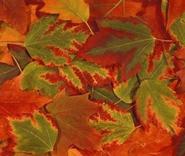
Duller fall leaf colors could be another effect of global warming, according to Hamilton College Professor of Biology Ernest H. Williams, Jr. "Our warming global climate threatens the full development of the colors we enjoy. The process of color change starts later than usual and doesn't develop as fully when summery warm weather pushes into the shorter days of fall," Williams explains.
He is the author of The Nature Handbook: A Guide to Observing the Great Outdoors (Oxford University Press, 2005). The book has a field guide format but is a guide to explain patterns and observations in nature.
Tree species are also being affected by global warming, Williams says. "Only certain tree species, most notably sugar maples and red maples, produce the pigment arrays responsible for most of the magnificent oranges and reds," he says. "And maples are declining in the Northeast because of our warmer climate. So one should take advantage of seeing the northern hardwood forests as they are now, especially when we have leaf-peeper weather, Williams suggests.
"Our northeastern hardwood forests are magnificent when cloaked in the warm colors of autumn, but the degree to which yellows, oranges, and reds develop depends on each year's climatic conditions. The green pigment chlorophyll, continuously produced in leaves until the days shorten, is essential for photosynthesis to occur, but it degrades more rapidly when we have sunny days, cold (but not freezing) nights, and dry weather," according to Williams. "With less chlorophyll, carotenoid pigments in the leaves are unmasked and give a yellow appearance. The same weather conditions also speed up the appearance of red-and-purple-producing chemicals known as anthocyanins, which form in part from the sugars in the leaves. This is the weather that leaf-peepers hope for: beautiful sunny days following cold nights."
He is the author of The Nature Handbook: A Guide to Observing the Great Outdoors (Oxford University Press, 2005). The book has a field guide format but is a guide to explain patterns and observations in nature.
Tree species are also being affected by global warming, Williams says. "Only certain tree species, most notably sugar maples and red maples, produce the pigment arrays responsible for most of the magnificent oranges and reds," he says. "And maples are declining in the Northeast because of our warmer climate. So one should take advantage of seeing the northern hardwood forests as they are now, especially when we have leaf-peeper weather, Williams suggests.
"Our northeastern hardwood forests are magnificent when cloaked in the warm colors of autumn, but the degree to which yellows, oranges, and reds develop depends on each year's climatic conditions. The green pigment chlorophyll, continuously produced in leaves until the days shorten, is essential for photosynthesis to occur, but it degrades more rapidly when we have sunny days, cold (but not freezing) nights, and dry weather," according to Williams. "With less chlorophyll, carotenoid pigments in the leaves are unmasked and give a yellow appearance. The same weather conditions also speed up the appearance of red-and-purple-producing chemicals known as anthocyanins, which form in part from the sugars in the leaves. This is the weather that leaf-peepers hope for: beautiful sunny days following cold nights."
Posted September 14, 2007
